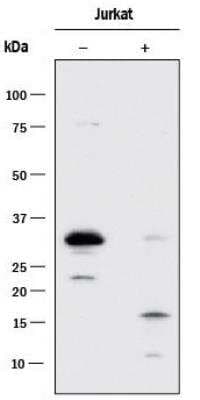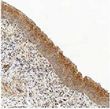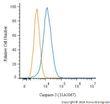Caspase 3 (CASP3) Mouse Monoclonal Antibody [Clone ID: 31A1067]
USD 200.00
USD 867.00
USD 436.00
Specifications
| Product Data | |
| Clone Name | 31A1067 |
| Applications | CyTOF-ready, Electron Microscopy, FC, ICC/IF, IHC, Immunoblotting, Simple Western, WB |
| Recommended Dilution | Immunohistochemistry: 1:10 - 1:500, Simple Western: 1:50, Western Blot: 1 - 5 ug/ml, Knockout Validated, Knockdown Validated, Immunohistochemistry-Frozen: 1:10 - 1:500, Immunohistochemistry-Paraffin: 1:10 - 1:500, Immunocytochemistry/ Immunofluorescence, Flow Cytometry, Electron Microscopy, Immunoblotting, Hematoxylin and Eosin Stain, Immunohistochemistry Free-Floating, CyTOF-ready |
| Reactivities | Human, Mouse, Rat |
| Host | Mouse |
| Isotype | IgG1, kappa |
| Clonality | Monoclonal |
| Immunogen | Full-length recombinant human caspase-3 protein was used as immunogen. The antibody recognizes an epitope in the large domain subunit of Caspase-3. As such it will recognize pro Caspase-3 and the large subunit cleavage fragment. |
| Formulation | PBS containing 0.05% BSA, 0.05% Sodium Azide. Store at 4C short term. Aliquot and store at -20C long term. Avoid freeze-thaw cycles. |
| Concentration | lot specific |
| Purification | Protein G purified |
| Conjugation | Unconjugated |
| Storage | Store at -20°C as received. |
| Stability | Stable for 12 months from date of receipt. |
| Gene Name | caspase 3 |
| Database Link | |
| Background | Caspases are a family of cysteine proteases that are key mediators of programmed cell death or apoptosis. The precursor form of all caspases is composed of a prodomain, and large and small catalytic subunits. The active forms of caspases are generated by several stimuli including ligand-receptor interactions, growth factor deprivation and inhibitors of cellular functions. All known caspases require cleavage adjacent to aspartates to liberate one large and one small subunit, which associate into a2b2 tetramer to form the active enzyme. Gene for Caspase-3 also known as Yama, CPP32, and apopain codes for a 32-kDa protein. Caspase-3 cleaves the death substrate poly(ADP-ribose) polymerase (PARP) to a specific 85 kDa form observed during apoptosis and is inhibitable by the CrmA protein. Other Caspase-3 substrates include DNA-PK, actin, GAS2, and procaspase-6, etc. Caspase-3 is activated by cleavage events at Asp-28/Ser-29 (between N-terminal pro-domain) and Asp-175/Ser-176 (between large and small subunits) to generate a large subunit of 17-kDa and a small subunit of 12-kDa. |
| Synonyms | CPP32; CPP32B; SCA-1 |
| Note | Useful in Immunohistochemistry-Frozen See Zhang et al., and Immunohistochemistry-Paraffin See Lee et al. Use in Immunocytochemistry/Immunofluorescence was reported in the scientific literature (PMID: 23840553). |
| Reference Data | |
| Protein Families | Druggable Genome, ES Cell Differentiation/IPS, Protease |
| Protein Pathways | Alzheimer's disease, Amyotrophic lateral sclerosis (ALS), Apoptosis, Colorectal cancer, Epithelial cell signaling in Helicobacter pylori infection, Huntington's disease, MAPK signaling pathway, Natural killer cell mediated cytotoxicity, p53 signaling pathway, Parkinson's disease, Pathways in cancer, Viral myocarditis |
Documents
| Product Manuals |
| FAQs |
| SDS |
{0} Product Review(s)
Be the first one to submit a review






























































































































































































































































 Germany
Germany
 Japan
Japan
 United Kingdom
United Kingdom
 China
China









